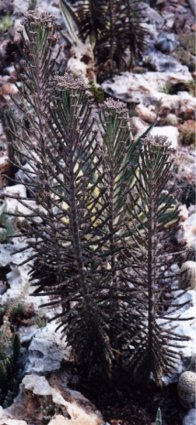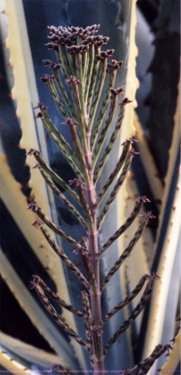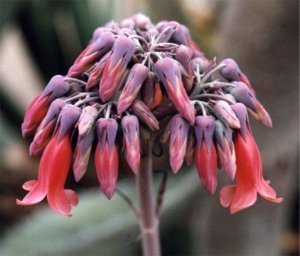Kalanchoe
by Valerie (August 11, 2000)
 
We have a lot of kalanchoes (Kalanchoe tubiflora). This plant comes as close to getting out of control as a tropical plant in a less-than-tropical climate can. The type of kalanchoe in our gardens has almost as many names as offspring. We always called it Cape Canaveral succulent, since it grows like a weed at that National Seashore. Its other names include coconut palm, pregnant mother, mother of thousands, mom's babies, air plant, magic plant, pregnant plant, piggy-back plant, Hollywood palm, and chandelier plant. This is why there are Latin names.
The kalanchoe is not a palm, but a type of succulent from Madagascar that happens to grow to three feet tall. These plants are perennials, but not in an area with winter freezes. The kalanchoes in our gardens typically live for 1 ½ years. The young plants are produced on the ends of tubular leaves and drop off all summer long. These small plants grow very slowly and a large number make it through the winter because they are protected from the freezes by the fact that they are down under the other vegetation. The next summer, they grow quite tall, producing babies all the time, then bloom the following winter, if we don't have an early freeze which kills the plants. The blossoms have never lasted long enough to go to seed since we always have a freeze sooner or later. Although it is uncommon, once in a while a large plant will survive the winter by not freezing all the way to the ground.
The only reason these plants continue to survive our climate (and the one feature that gives them most of their common names) is that they reproduce prolifically. A plant needs to be only about 1 ½ to 2 inches tall before it begins to propagate. The tiny plantlets have a high survival rate, even during the hottest part of the summer, subsisting on stored water in their gray, disk-shaped leaves. They also manage to end up in places that seem unnatural considering that they are usually dislodged by rain or a water sprinkler. The plants may appear uphill from the original plants, or high up on top of other plants. It's as if they can jump around.
After the baby plant finds a root-hold, it begins to send up a stem and leaves that are more tubular like the adults. The kalanchoes are very attractive, with their symmetrical arrangement of thick leaves covered with dark green blotches, each tipped with a young plant, growing from a single, tall, thick stem. The flowers are also pretty, looking somewhat like porcelain with a delicate coral coloring. They are an excellent plant for our hot, dry weather, and add a nice exotic touch to our gardens. |
 Then the next summer it will grow one or more new stems.
Then the next summer it will grow one or more new stems.
